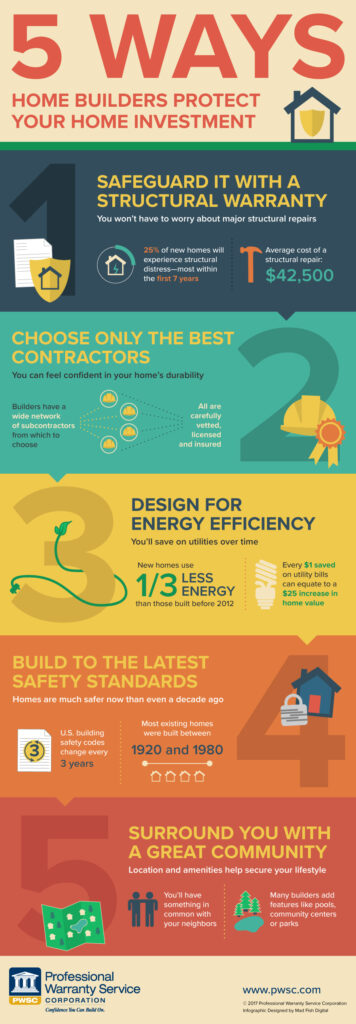Your home should be the place you hang your hat—not your wallet.

It’s a big investment, sure. But that doesn’t mean it has to be a risky one. In fact, you can significantly lower your home-buying risks simply by opting for a newly built home over an existing one. And if your builder offers an insured structural warranty for new homes, your risks are reduced even further.
Two in five Americans say they’d rather buy a new home than one that’s been previously lived in—that’s twice as many as those who prefer existing homes. Why? Here’s a hint: It’s not just because of that new-house smell.
When you buy a newly constructed home, you also get a builder who has your back. Your home builder is more than just someone who sells you a house; they’re also there to help protect your investment. This is more than likely not the case with a resale home! Choose a newly built home, however, and work with a builder who will:
- Safeguard it with a structural warranty
One of the biggest perks of owning a new home is that you won’t need to tackle any major home repairs for a while. Even if one of the brand-new components does fail—if the roof starts leaking, for example—your home builder warranty services will pick up the tab.
“A new home is generally fully warrantied by the builder for a minimum of a year, and most of all the other components are warrantied for extended periods,” says Jack McCabe of McCabe Research & Consulting.
Structural warranties for new homes typically cover defects in workmanship and materials for one year, major home systems like wiring and plumbing for another year, and structural failures for the first decade of your home’s life.
With an older home, a major foundation or structural repair would have to come straight out of your pocket. “When you buy a resale home, even if you have a home inspection done, it still does not turn up hidden defects that you don’t find out about a lot of times for two years,” McCabe says.
Most homeowners can’t afford to take that risk. A major repair can run you $800 or more, while average replacement costs run upwards of $1,200. Yet six in 10 homeowners say even a home repair costing less than $2,000 would break their budget.
That’s why more than half of the homeowners who prefer newly built homes say it’s because they want fewer maintenance and repair costs. All in all, new-construction homeowners generally pay less than a third of the monthly maintenance and repair costs that most homeowners have to juggle.
- Choose only the best contractors
A house is generally expected to last for at least 75 years. In reality, the durability of a home’s construction can have a big impact on its lifespan.
When you buy an older home, McCabe points out, you don’t really know what you’re getting. Even if you can pinpoint who the original builder was, there’s often no telling what might have been done to it since then. Shoddy work by unlicensed contractors can undermine the long-term durability of your home.
With a newly built home, you have the luxury of choosing a builder with a reputation for quality. Today’s quality builders carefully vet all of their subcontractors, ensuring they have the necessary licenses, insurance and qualifications. They have access to a whole network of contractors, enabling them to choose only the very best people to work on your home.
- Design for energy efficiency
Today’s new homes are far more energy efficient than those built even just six years ago—and they’re constantly improving. Homes built after 2012, for example, reduce energy usage by more than a third compared to those built just a few years before. Buying a new home means you could pay up to 50 percent less to heat, light and cool your living space.
Newly constructed homes are more energy efficient in two ways, says Kevin Morrow, senior program manager for the National Association of Home Builders’ green building programs:
- Tighter building envelope. High-efficiency insulation, double- or triple-paned windows, and better doors help keep cool air inside during the summer and prevent warm air from escaping in the winter.
- Greener systems and appliances. Energy-efficient water heaters, furnaces, AC units, refrigerators and washing machines consume fewer resources. Nine in 10 home buyers include Energy Star appliances on their most-wanted list.
All this enhanced energy efficiency does more than just save you money on utility bills. It also helps increase the overall value of your home. Every $1 you save on utility bills can correspond to up to a $25 increase in your home’s value.
- Build to the latest safety standards
Two in five homeowners who prefer new homes say it’s because they want to live in a home that meets modern construction standards. That’s a smart choice, when you consider how much building safety codes have changed over the years.
U.S. building codes, which regulate everything from materials to construction methods, are updated every 3 years to reflect the latest advances in technology and engineering. Since most existing homes were built between 1920 and 1980, that puts resale homes at a serious disadvantage compared to newly built ones. A brand-new home built to the most current safety standards will feature, among other things:
- Enhanced fire safety. Newly constructed homes often include fire safety features that older homes may not have. For example, all new homes are required to include smoke detectors that are hard-wired into your home’s electrical wiring so they’re less prone to failure than their battery-operated counterparts. Additionally, new wiring makes homes less prone to fire, while fire retardant in the carpeting and insulation lowers their flammability.
- Better natural disaster protection: Building codes are often updated to make homes more resilient during earthquakes, storms and hurricanes. The latest foundations, support beams and windows are designed to weather natural disasters much better than their predecessors. The Environmental and Energy Study Institute estimates that Florida homes hit by Hurricane Andrew would have suffered 50 percent less damage if they’d been built to the latest safety codes.
- Safer indoor environment: Today’s building codes also take into account indoor air quality as well as the overall toxicity of your home’s environment. While many older homes were constructed using hazardous substances like asbestos or lead-based paint, newer homes are free of these types of materials. Cabinets, carpets and paints all include fewer volatile organic compounds, while a state-of-the-art HVAC system will filter the air far more effectively than an older model.
“Building codes can have a profound impact on the comfort and safety of residents as well as the cost of construction and the cost of operating the home,” says the National Association of Home Builders.
- Surround you with a great community
Today’s larger builders don’t just plan new homes. They design entire communities based around a certain lifestyle.
Whether that means living in a luxury neighborhood with a resort-style pool and clubhouse or simply having lots of parks and hiking trails nearby, new homeowners have the opportunity to surround themselves with neighbors with which they might have something in common. In fact, one of the top six reasons people love newly built homes is that they get to live in a newly developed neighborhood next to other new homes.
Bottom line: Buying a home is a quality-of-life investment as well as a financial one. A top-notch home builder will help protect your investment on both fronts.




